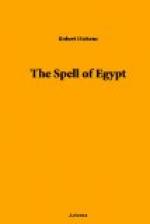As I rode back toward the river, I saw again the boy clad in the rope of plaited grass, and again he said, less shyly, “May your day be happy!” It was a kindly wish. In the dawn I had felt it to be almost a prophecy. But now I was haunted by the face of the goddess of Denderah, and I remembered the legend of the lovely Lais, who, when she began to age, covered herself from the eyes of men with a veil, and went every day at evening to look upon her statue, in which the genius of Praxiteles had rendered permanent the beauty the woman could not keep. One evening, hanging to the statue’s pedestal by a garland of red roses, the sculptor found a mirror, upon the polished disk of which were traced these words:
“Lais, O Goddess, consecrates to thee her mirror: no longer able to see there what she was, she will not see there what she has become.”
My Hathor of Denderah, the sad-eyed dweller on the column in the first hall, had she a mirror, would surely hang it, as Lais hung hers, at the foot of the pedestal of the Egyptian Aphrodite; had she a veil, would surely cover the face that, solitary among the cruel evidences of Christian ferocity, silently says to the gloomy courts, to the shining desert and the Nile:
“Once I was worshipped, but I am worshipped no longer.”
VII
KARNAK
Buildings have personalities. Some fascinate as beautiful women fascinate; some charm as a child may charm, naively, simply, but irresistibly. Some, like conquerors, men of blood and iron, without bowels of mercy, pitiless and determined, strike awe to the soul, mingled with the almost gasping admiration that power wakes in man. Some bring a sense of heavenly peace to the heart. Some, like certain temples of the Greeks, by their immense dignity, speak to the nature almost as music speaks, and change anxiety to trust. Some tug at the hidden chords of romance and rouse a trembling response. Some seem to be mingling their tears with the tears of the dead; some their laughter with the laughter of the living. The traveller, sailing up the Nile, holds intercourse with many of these different personalities. He is sad, perhaps, as I was with Denderah; dreams in the sun with Abydos; muses with Luxor beneath the little tapering minaret whence the call to prayer drops down to be answered by the angelus bell; falls into a reverie in the “thinking place” of Rameses II., near to the giant that was once the mightiest of all Egyptian statues; eagerly wakes to the fascination of record at Deir-el-Bahari; worships in Edfu; by Philae is carried into a realm of delicate magic, where engineers are not. Each prompts him to a different mood, each wakes in his nature a different response. And at Karnak what is he? What mood enfolds him there? Is he sad, thoughtful, awed, or gay?
An old lady in a helmet, and other things considered no doubt by her as suited to Egypt rather than to herself, remarked in my hearing, with a Scotch accent and an air of summing up, that Karnak was “very nice indeed.” There she was wrong—Scotch and wrong. Karnak is not nice. No temple that I have seen upon the banks of the Nile is nice. And Karnak cannot be summed up in a phrase or in many phrases; cannot even be adequately described in few or many words.




